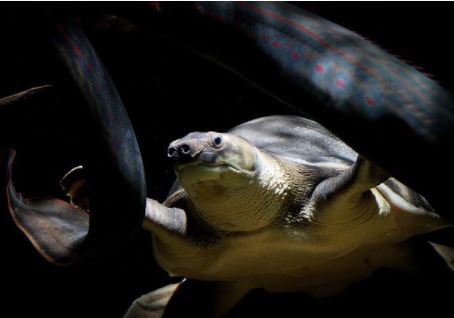How to keep turtle aquarium from smelling?
It can be challenging to keep an aquarium from smelling for a few reasons.
The water evaporates and leaves behind dissolved substances that by themselves or in combination with other substances produce an odor; aquatic plants also release odorous compounds into the water; and dead fish may decompose, releasing gasses that add additional smells.
The good news is there are ways to keep your tank from smelling!
Below, we have outlined some of these methods including how often to clean your tank, what type of filter you should use for this job, and more.
Related Posts:
- Top 5 Turtle Substrate for Your Pet Tank
- Can Turtles Live in a Fish Tank Filled With Water?
- Can Turtles Eat Spider Plants?
- Can I Use a Fish Water Conditioner for Turtles?
- Can I Keep My Turtle Tank Outside?
How to Keep Turtle Aquarium From Smelling?
How to keep turtle aquarium from smelling?
This is a common issue for many aquarists and an easy fix.
First, your turtle’s aquarium does not need to be cleaned as often as you think.
I clean my turtles’ home every 3-4 months and the only thing that needs to be replaced annually are the waterfowl pellets, the freshwater eelgrass or aquatic plants, and maybe some of the gravel if it is looking noticeably dirty.
This means much less work for you!
Find an eco-friendly way to naturally eliminate unwanted smells from your turtle’s habitat.
Now that we’ve covered how often you really need to clean, let’s look at why your turtle tank might be smelling in the first place.
If your turtle’s home is too small or dirty, it can lead to excess waste and bad bacteria that create a strong unpleasant odor. Make sure you consider these few guidelines:
- Turtles need at least 20 gallons of water per inch (of shell). For example, a red-eared slider needs 55 gallons minimum.
- A good rule of thumb for the depth of substrate is 2x the size of your turtle’s shell. For example, my turtles each have 2″ deep substrates, so I use about 4 inches in my tank as well as rocks and driftwood to give them some floor elevation and more places to hide.
- A box turtle needs an even bigger footprint than other species because they are not as active, so plan accordingly.
- Make sure that your turtle’s home has a secure screen cover to prevent escape and injury, but be sure to allow for airflow, or else, the tank could start to smell from lack of oxygen. In addition, since turtles are living creatures, there will likely be some degree of waste produced in their habitats, which can cause unpleasant odors if not properly maintained.
You do not need a filter on your turtle’s tank because they get most of their oxygen through the water surface and you don’t want them getting sucked into a filter intake during feeding time!
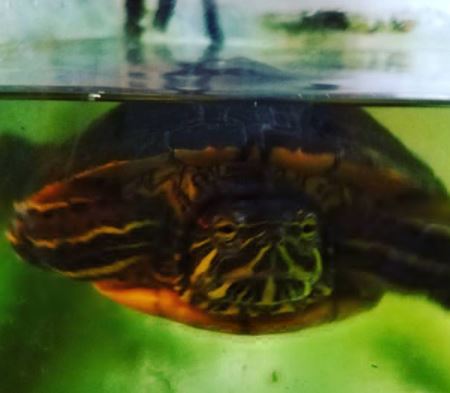
I keep my system running flawlessly with daily feedings by doing the following:
- Feed twice a day if possible.
- Keep 1/2 -3/4″ of gravel in the tank.
- Do not give your turtle any food that is processed or contains sugars (such as whole fish, canned cat/dog food, dry kibble, bread).
- Rinse feeder fish before feeding. Don’t worry if you kill them by accident when you rinse them because their loss will be negligible to your turtles’ health, but they will play an important role in biofiltration.
- Use Eco Earth or Hatch Rize (for indoor setups only).
- Plant live aquatic plants like Anacharis and Duckweed inside the home to provide natural filtration and hiding places for your turtles.
- If there is a huge buildup of waste on top of the substrate or stuck on the glass, remove as much as you can without disturbing the turtles with a turkey baster or siphon hose. To clean rocks and driftwood, I scrub them with a toothbrush using hot water.
- Use Prime to detoxify any chlorine or ammonia in your tap water before adding it to your tank so that your turtle’s environment will be safe for them!
All of these steps keep my turtle tanks from stinking up the house. As long as you stick to a routine and remember not to overfeed them, most turtle owners find that their habitats stay fresh-smelling all year around.
Scoop poop into an old plastic baggie and seal it tightly until it is time for outdoor disposal. It makes me sad when I see people buying turtle habitats that smell like a human bathroom. It is not healthy for you or your pets.
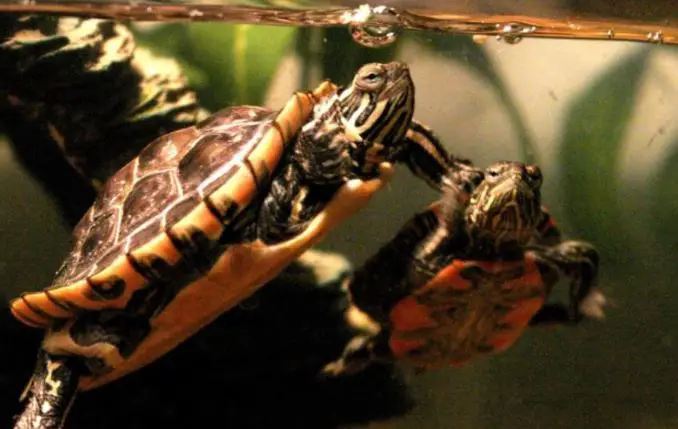
Why Does My Turtle Tank Stink?
You now know how to keep turtle aquarium from smelling, but why does a turtle tank stink in the first place?
A lot of people who want to own turtles end up asking this question.
Believe it or not, most of them start this hobby thinking that turtles are low-maintenance pets.
However, over time they soon find out that caring for these cold-blooded reptiles is quite different from having caged birds or other common household pets in the home.
One of the basic things that you should be doing regularly is cleaning your pet turtle’s tank. If you do not clean your turtle aquarium frequently enough, there will come a point when foul odor coming from your turtle tank becomes intolerable even for you.
When discussing turtle tanks, we have always stressed the importance of giving our terrapins a place where they can feel safe and secure.
This means that you must put them in a spacious enclosure where they can crawl around, hide under rocks or pieces of wood, bask on specially-made turtle basking platforms, sleep at night, feel safe from fish or other turtles nipping at their flesh or even bully them for no reason whatsoever.
Does My Turtle Tank Smell Bad Because It Needs to Be Cleaned Up?
Of course! Even if you don’t feed your turtles anything, they will still excrete waste products that accumulate inside their enclosures.
As the old saying goes, “Desperate times call for desperate measures.” If you are experiencing this problem right now, maybe there is something wrong with how you take care of your terrapins.
It could be that your turtles are not receiving enough water or that their tank is not big enough for them to swim around in.
You might also want to consider the type of bedding you use when cleaning up your turtle tank.
Some people make the mistake of using sand instead of specialized terrapin soil, which is easier to keep clean and can absorb most, if not all, of the excreted wastes inside the turtle tank.
You need to understand that something like this can literally stink up an entire room in a matter of minutes, so be sure to take steps early on before it gets out of hand.
If your house starts smelling too much like a sewer or a public toilet due to dirty turtle tanks, you may have no choice but to get rid of your pets and find a way out of this mess.
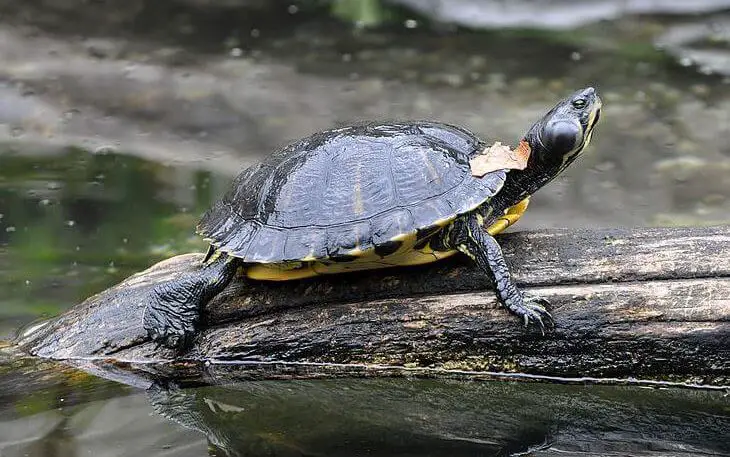
Why Does Turtle Tank Smell Like Rotten Eggs?
The answer usually is related to the red-eared slider and yellow-bellied slider turtles.
The problem is that they excrete very bad-smelling feces and can be quite hard to clean up.
Sometimes, the place that they normally use as a basking area smells really bad even if it’s cleaned regularly. This article tries to answer the question, “Why do turtle tank smell like rotten eggs?”
People keep their aquatic turtles in aquariums or tubs filled with water for them to swim freely and breed naturally.
But sometimes, people who keep them as pets notice a particularly strong odor coming from what seems to be their favorite spot to bask: the freshwater.
This is an indication that you might have a smelly turtle in your aquarium or tub.
In order for them to live healthily, they need a proper habitat, a clean basking area, and adequate living space.
But when they start smelling bad, then it is time to check on the turtles’ environmental condition and ask yourself this question, “Why does a turtle tank smell like rotten eggs?”
Why Is My Turtle Water Cloudy?
If you have done what you could to keep turtle aquarium from smelling but the water is still cloudy, read on!
To answer this question, you have to find the cause of the cloudiness first before anything else. It is very important that you identify what caused the problem so you can prevent it from happening again next time.
There are many reasons why your pond or tank water could be cloudy and dirty, but let’s take a look at some of them in more detail:
1. Undesired Bacteria in the Tank Environment
Some bacterial growth may be beneficial for turtles in their natural environment, but they can also cause harm when not kept in check by other organisms because then they grow out of control and lead to infection in your pet turtle.
Bacteria can enter your turtle environment by any means. For example, through the food you feed your reptiles.
By not thoroughly washing these before putting them into the water or even cleaning aquarium filters, you are adding undesired bacteria to your turtles’ environment.
Bacteria are tiny organisms that simply multiply very fast and outgrow other helpful organisms in their habitat if they aren’t controlled.
This is called bad bacteria. A build-up of bad bacteria on the animals’ skin or inside their body may lead to problems like eye infections or even death if not treated properly.
You need to identify if this is what causes cloudy turtle water so you can start doing something about it right away!
2. There Are Parasites in the Tank
Parasites are organisms that attach themselves to the turtle’s body and absorb its nutrients.
The most common parasite that causes issues in turtle tanks is called Giardia, which spreads very fast, especially if other turtles are kept in the same tank or pond.
3. The Tank Water Is Dirty
Once you have found the cause of the cloudy water, take a good look at the quality of it, too.
If you use tap water directly from your faucet, chances are that contains chlorine, which will kill helpful agents in your turtle environment such as fish and bacteria that break down waste into less harmful substances.
This means that you need to remove the chlorine from tap water before you can use it in your turtle tank or pond by using a simple and easy-to-use water filter, for example.
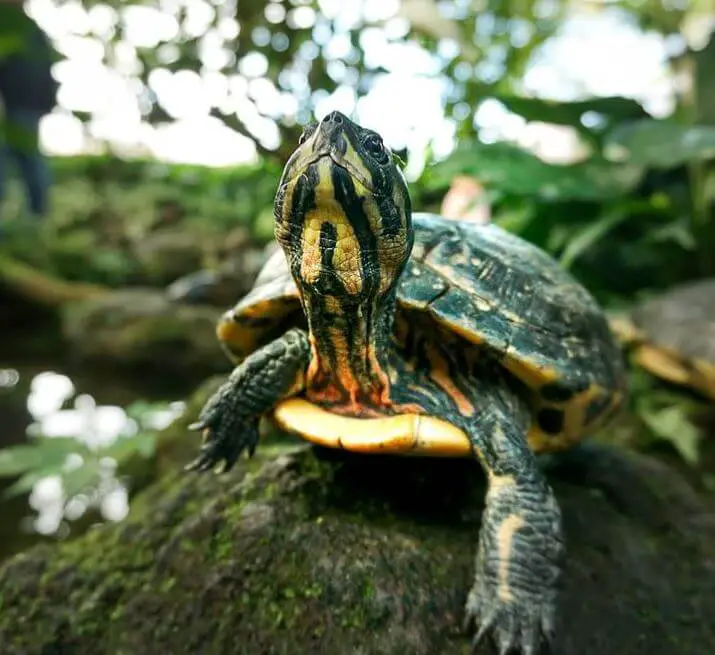
How to Clear Cloudy Turtle Water?
To keep turtle aquarium from smelling, clearing the cloudy turtle water may be part of the process.
It is really frustrating to see your aquatic turtles living in cloudy and dirty water.
The first thing you need to do is find out what’s wrong with the water. Also, learn about the harmful effects of cloudy and dirty turtle water and how to prevent them from happening again.
Turtles love spending their time swimming and playing in clean water where they can easily breathe.
It’s not only turtles that live on land. Those who live in ponds also need clean and fresh water for survival as well as good health.
These animals depend on you as an owner to provide them with a healthy environment like they would in their natural habitat.
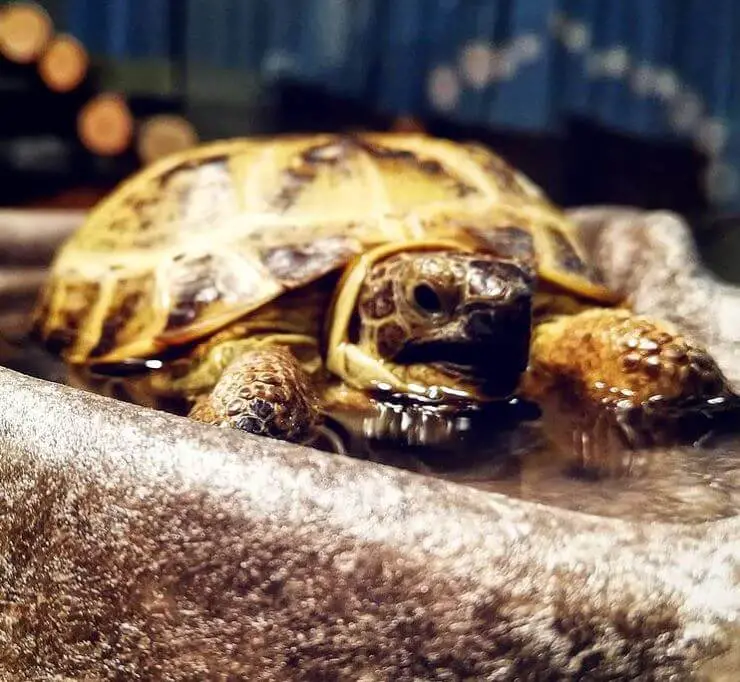
How Often Do I Need to Clean a Turtle Tank?
How often do you need to clean to keep turtle aquarium from smelling?
You should remove your turtle’s waste at least once daily, preferably using a siphon.
The water must also be completely changed between 15%-25% every week. Usually, it is easier to change more than this rather than less so you will know when it is time for another water change soon enough.
Most people recommend monthly full changes during the winter months and twice-monthly changes in the summertime depending on how warm your house gets since warmer temperatures can cause increased evaporation from the tank!
Many people find that they have to do weekly water changes during spring and fall as well even if their turtles are outside or in an aquarium with a filter
It all just depends on the type of turtle, the size of the tank, and how many turtles there are in it. In a habitat with more turtles or a smaller water volume, you will have to change the water more often!
If your turtle has any history of respiratory illness or if they have been exposed to other sick turtles when you get them from a store (which can happen), you should monitor their feces carefully and do daily water changes until they pass all of it and remain healthy for over a week.
You may be able to get away with doing even less since these conditions encourage increased defecation, but if your new turtle is not eating well at all, then daily cleaning is required.
Don’t forget that algae eaters such as plecos tend to need rotation every few weeks because they can produce a lot of waste, too!
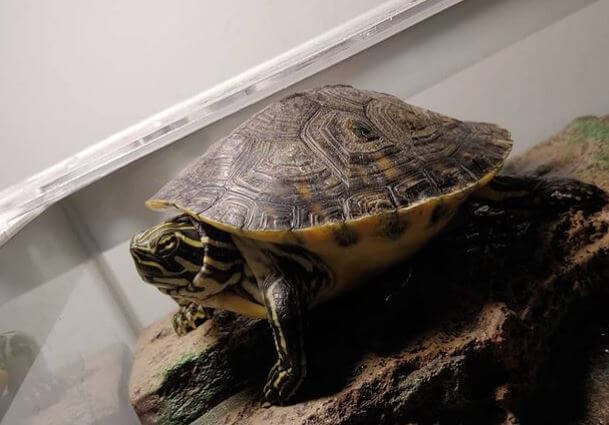
Can You Use the Same Substrate for Turtles?
Yes, if it is non-toxic like gravel or sand. Many substrates contain chemicals that are very harmful to your turtle’s health, so make sure you read all package labels carefully before putting anything in their habitat!
Some people also recommend using freshwater river rocks since they don’t require special maintenance and help keep the tank cleaner by providing hiding places for algae-eating fish, which reduces water quality problems.
You can put aquarium plants in your turtle’s tank but watch out: some types of plants are toxic.
Make sure you research what is safe first.
It may be better to stick with fake plants instead of living ones because some turtles love destroying them while others are fascinated with eating them!
If you have a tank that is too small to accommodate both the turtle and the filter, choose your best friend: the filter.
It can’t do its job if turtles are causing too much of a commotion in the tank! Be sure that you clean out all filters very carefully after each weekly water change because they build up waste quickly, especially when turtles are in them.
If you don’t clean them regularly enough, they can create more problems for your turtles by adding to their toxic load, which makes it harder for their bodies to fight against illness until eventually permanent damage is done.
You must take great care in removing every ounce of feces from the pump impellers before replacing your filtration system!
Conclusion
How to keep turtle aquarium from smelling?
The best way to keep your turtle’s aquarium from smelling is by adding a filter and/or water conditioner.
If you’re looking for an easy solution, we recommend using the Tetra AquaSafe Water Conditioner or Aquapure Filter.
You can also try cleaning out the tank every so often with old newspaper and baking soda to decrease odor.
Whatever method you decide on, be sure it will work well in the size of your tank as turtles are messy creatures!
Key points as to why your turtle tank may be smelling:
A foul smell emanating from your turtle tank can result from various factors, often signaling the need for adjustments or cleaning. Here’s a concise breakdown in bullet points for quick reference:
1. Inadequate Filtration:
- Ammonia Build-Up: Insufficient filtration leads to the accumulation of waste and uneaten food, causing ammonia levels to rise and emit a strong, unpleasant odor.
- Solution: Upgrade or clean your filtration system regularly to effectively remove waste and maintain water quality.
2. Poor Water Quality:
- Decaying Organic Matter: Rotting plants, uneaten food, or excess waste in the tank contribute to bacterial growth, producing a foul odor.
- Solution: Perform partial water changes (around 25-50%) regularly to remove debris and maintain water quality.
3. Dirty Tank Conditions:
- Dirty Substrate: Accumulated waste and uneaten food particles in gravel or substrate can decompose, causing a pungent odor.
- Solution: Clean the tank substrate thoroughly during regular maintenance to remove waste and prevent bacterial growth.
4. Inadequate Tank Cleaning:
- Infrequent Tank Cleaning: Irregular cleaning schedules allow waste to accumulate, leading to odor issues.
- Solution: Establish a routine for tank cleaning, including water changes, substrate cleaning, and filter maintenance.
5. Overfeeding:
- Excess Food Waste: Overfeeding results in more uneaten food, contributing to increased waste and foul odors.
- Solution: Feed your turtle appropriate portions, and remove uneaten food promptly to prevent decay and maintain water quality.
6. Decomposing Organic Matter:
- Dead Plants or Animals: Decaying plant matter or deceased tank mates can emit unpleasant odors.
- Solution: Remove any dead organisms or decaying matter promptly to prevent odor issues.
7. Improper Equipment Maintenance:
- Dirty Filters or Equipment: Filtration systems, pumps, or other tank equipment accumulating debris can contribute to odors.
- Solution: Regularly clean and maintain tank equipment to ensure proper functionality and reduce odor.
8. Environmental Factors:
- High Temperature: Elevated temperatures can accelerate bacterial growth and worsen odor problems.
- Solution: Ensure the tank temperature is appropriate for your turtle species and consider using fans or coolers if needed.
Addressing a smelly turtle tank involves maintaining cleanliness, proper filtration, and a balanced environment. Regular maintenance and prompt intervention can prevent odor issues and ensure a healthier habitat for your pet turtle.
Further Reading:
- 7 Best Plants for Turtle Tank
- 5 Best Turtle Basking Platforms
- How Big of a Tank for a Painted Turtle?
- Can You Put Sand in Your Turtle Tank?
- How Many Watts for Turtle Basking?

